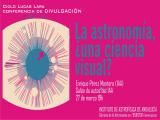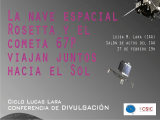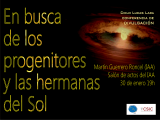Archivo de noticias y eventos
751 - 800 de un total de 1805
También puede acceder a la lista de noticias publicadas en los medios relacionadas con el Instituto de Astrofísica de Andalucía - CSIC.
Pages

|
08/04/2014 - 14:30
The IAA Cloud Service The rise in speed of communications and the decline in prices of storage elements, has caused we can put some of our information on the net in order to make it available easily from anywhere. In this sense, it is said that your information is hosted in the cloud. Nowadays, there are several software solutions to sync and sharing files on the cloud, like Dropbox, Google Drive or Sky Drive, among others. In the IAA, a cloud... Francisco Manuel Bayo Muñoz and Juan José Guijarro Jiménez |

|
03/04/2014 - 14:30
A ring system detected around the Centaur (10199) Chariklo We will report observations of a multichord stellar occultation that revealed the presence of a ring system around the centaur object (10199) Chariklo. There are two dense rings,with respective widths of about 7 and 3 kilometres, optical depths of 0.4 and 0.06, and orbital radii of 391 and 405 kilometres. We will also present more results obtained after the occultation on June 3rd 2013. Photometric and spectroscopic... Dr. Rene Duffard |

|
27/03/2014 - 18:00
La astronomía, ¿una ciencia visual? Entendemos la astronomía como un área en que la percepción visual cobra gran importancia y los astrónomos como científicos con gran agudeza visual. Veremos que esto no es así y que los avences teóricos y observacionales de la astronomía se han producido cuando hemos dejado de atender tanto a lo que nuestros ojos nos muestran. Enrique Pérez Montero |

|
27/03/2014 - 13:30
New findings on the X-ray emission from Wolf-Rayet nebulae We present the most recent results of XMM-Newton and Chandra observations on the only four Wolf-Rayet (WR) nebulae observed to date. Given the limited number of observations and the different morphological and spectral characteristics of these nebulae, it has been difficult to understand the physics behind the plasma emission. Numerical and analytical models can not explain the 'soft' nature and low plasma temperatures (T~106 K)... Jesús A. Toalá |

|
20/03/2014 - 13:29
The Nature of the IR Emission in Low-Luminosity AGN at Parsec Scales The vast majority of AGN belong to the low-luminosity class (LLAGN): they exhibit a low radiation efficiency (L/Ledd < 10^-3) and the absence of the big blue bump in their spectra, a signature of the accretion disk. The study of LLAGN is a complex task due to the contribution of the host galaxy, whose light outshines these faint nuclei. As a consequence, numerical models are usually compared with relatively poorly defined spectral energy... Juan Antonio Fernández Ontiveros |

|
13/03/2014 - 13:30
Quasars and their emission lines as cosmological probes Quasars are the most luminous stable sources in the Universe. They are currently observed out to redshift z ~ 7 when the Universe was less than one tenth of its present age. Since their discovery 50 years ago astronomers have dreamed of using them as standard candles. Unfortunately quasars cover a very large range (8 dex) of luminosity making them far from standard. I briefly review several methods that can potentially exploit quasars... Dr. Paola Marziani |

|
06/03/2014 - 13:30
La Asociación de Mujeres Investigadoras y Tecnólogas (AMIT) La incorporación de la mujer a la investigación, la docencia o la gestión de la Ciencia y las Humanidades supone un progreso social. La participación de las mujeres en estas esferas, sin embargo, no es igualitaria respecto a los hombres en la España de comienzos del siglo XXI. La presencia de la mujer es dramáticamente decreciente a medida que se sube en los escalones profesionales. AMIT es una... J. Masegosa |

|
27/02/2014 - 18:00
La nave espacial Rosetta y el cometa 67P viajan juntos hacia el Sol Los responsables de la misión han proyectado el viaje de Rosetta hacia el cometa de tal manera que el encuentro con el cometa 67P se produzca cuando este se sitúe a unos 675 millones de kilómetros del Sol. Entonces, el cometa apenas presentará actividad y su forma se reducirá a una bola compuesta de hielo y, posiblemente, material rocoso, materiales que, se piensa, pueden constituir los restos inmaculados de la formación del Sistema Solar. Luisa M. Lara |

|
26/02/2014 - 10:30
Espectroscopía de Elfos y Duendecillos Desde que a finales de los años 80 se descubrieran los duendecillos atmosféricos (Red Sprites) y los elfos (ELVES) muchos han sido los intentos por determinar sus características espectroscópicas. Los Sprites son enormes descargas eléctricas asociadas a intensos rayos positivos nube-tierra que se extienden desde la baja ionosfera hasta bien entrada la mesosfera y unos pocos milisegundos de duración.... Francisco C. Parra Rojas Sala de Juntas del Nuevo Edificio (IAA-CSIC) |

|
20/02/2014 - 13:30
The AGN nature of LINER nuclear sources The origin of the main excitation mechanisms in LINER (Low Ionization Emission Line Region) nuclei are still controversial, with nonstellar photoionization, fast shocks or hot stars as the principal candidates. In the AGN scenario, LINERs could represent the link between more powerful AGN and normal galaxies as suggested by their low X-ray luminosities. Their interest increases as they would be the dominant population of active... Dr. I. Márquez |

|
13/02/2014 - 13:30
A powerful new method to measure the atmospheric water vapour column. We have developed a reliable powerful method to measure the atmospheric column of water vapour (PWV) down to very low levels. For this purpose we use and off-the-shelf cheap spectrometer to measure the equivalent width of the H2O bands at 940nm. In order to calibrate the measurements we use the radiative transfer model included in the package SCIATRAN to produce theoretical solar spectra as observed on the ground, based on simultaneous... Prof. E. Pérez |

|
12/02/2014 - 15:00
Identificación de la contrapartida óptica e infrarroja de la fuente transitoria J0109+6134 detectada por Fermi LAT Estudio de la contrapartida óptica e infrarroja de la fuente de rayos gamma J0109+6134. Investigaciones previas apuntan a que esta fuente es un blazar visto a través del plano galáctico. El propósito principal fue confirmar la contrapartida óptica previamente propuesta, estudiando su comportamiento en el tiempo. Para ello se llevó a cabo una campaña de fotometría diferencial CCD de... Estela del Mar Fernández Valenzuela Sala de Juntas del Instituto de Astrofísica de Andalucía (IAA-CSIC) |

|
06/02/2014 - 13:30
The bricks of the Very Large Telescope Interferometer In this talk we will perform a review of the basic principles of the optical/near-infrared interferometry and of the current European facilities to use this observational technique. Particularly, we will describe the interferometric observables used at near-infrared wavelengths. We will provide a review of the current (and future) instruments available at the ESO Very Large Telescope Interferometer (VLTI), their advantages and limitations as... Lic. Joel Sánchez Bermúdez |

|
30/01/2014 - 18:00
En busca de los progenitores y las hermanas del Sol El Sol, y el Sistema Solar con él, se formó en algún lugar de la Vía Láctea hace cuatro mil quinientos millones de años. Desde entonces se inició un gran viaje a través de la Galaxia que nos ha ido separando más y más del entorno en el que se formó el Sol. Martín Guerrero Roncel |

|
30/01/2014 - 13:30
The CHESS survey of the protostellar shock L1157-B1 Outflows generated by protostars heavily affect the kinematics and chemistry of the hosting molecular cloud due to strong shocks. These shocks heat and compress the ambient dense gas switching on a complex chemistry that leads to an enhancement of the abundance of several species, as reported in "chemically active" outflows, whose archetype is the outflow of the low-mass Class 0 protostar L1157. I'll present the results of... Dr. Gemma Busquet |

|
29/01/2014 - 15:00
Unos cuantos (cuentos) de gravedad Presentación informal de los siguientes contenidos: (1) descripción de las interacciones fundamentales en términos de partículas mediadoras, (2) la teoría clásica de gravedad que se sigue de la autointeracción de gravitones, (3) discusión del problema de la constante cosmológica en este contexto. Habrá galletas fritas. Raúl Carballo Rubio Sala de Juntas del Instituto de Astrofísica de Andalucía (IAA-CSIC) |

|
23/01/2014 - 13:30
Nucleosynthesis and molecular processes in evolved stars Most of the stars (M < 8 solar masses) in the Universe end their lives with a phase of strong mass loss and experience thermal pulses (TP) on the Asymptotic Giant Branch (AGB), just before they form Planetary Nebulae (PNe). They are one of the main contributors to the enrichment of the interstellar medium and thus to the chemical evolution of galaxies. More specifically, the more massive AGB stars form very different isotopes (such as... Dr. Anibal García Hernández |

|
16/01/2014 - 13:30
Bar parameter evolution over the last 7 Gyr The tumbling pattern of a bar is the main parameter characterising its dynamics. This bar pattern speed, the bar ellipticity and its length are the three observational parameters that fully characterize bars. From numerical simulations, their evolution since bar formation is tightly linked to the dark halo in which the bar is formed through dynamical friction and angular momentum exchange. Observational ... Dr. Isabel Pérez |

|
15/01/2014 - 10:00
Damped Lyman-alpha Systems A finales de los 50 y principios de los 60 se descubrieron una serie de fuentes muy intensas en radio. El espectro óptico de estos objetos desconcertó al principio a la comunidad científica, ya que se observaban una serie de lineas en emisión y absorción que no se habían visto antes, hasta que se se cayó en la cuenta de que eran "las de siempre" desplazadas al rojo. Son los Quasi-... Rubén Sánchez Ramírez Sala de Juntas del Instituto de Astrofísica de Andalucía (IAA-CSIC) |

|
19/12/2013 - 18:00
La medida del Universo: la misión GAIA ¿Cómo sabemos la distancia al Sol? ¿Cómo conocemos la distancia a los planetas?, ¿y a las estrellas? El ser humano ha desarrollado diversos métodos y herramientas para medir la distancia a los cuerpos celestes. Una especie de juego de muñecas rusas en el que cada método está basado y calibrado en función de los resultados del anterior. A esta colección de métodos... Emilio Alfaro |

|
05/12/2013 - 13:30
Stellar water fountains: planetary nebulae in the making Planetary nebulae (PN) are one of the final phases in the evolution of low and intermediate mass stars (<8 Msun). They display a great variety of shapes, although in their previous phases (Asymptotic giant branch =AGB) they have a spherical geometry. The transition from spherical symmetry to asymmetry must occur during the short post-AGB phase or in the early PN phase. Here we present a special type of evolved stars, called "... Dr. JFrancisco Gómez |

|
28/11/2013 - 13:30
Galaxy clusters: galaxy laboratories and cosmological probes. A see you later seminar. In this talk -my last one in the IAA for the moment- I will talk about the largest structures in the Universe: galaxy clusters. The first part of the talk will be focused on galaxy clusters embedded in the large scale structure: how we detect them and how we can use them to provide estimations of cosmological parameters. In the second part, I will talk about the galaxies living in clusters, in particular, about the brightest cluster... Dr. Begoña Ascaso |

|
27/11/2013 - 10:30
Deconvolución de datos fotométricos SHARDS y IRAC: aplicación al estudio de LAEs a z>5 Los estudios fotométricos en óptico en IR de fuentes débiles son una perfecta alternativa a la espectroscopía, ya que ésta última técnica es ineficiente para este tipo de fuentes. Sin embargo, las imágenes fotométricas pueden poseer bajas resoluciones, tanto espacial como angular. La baja resolución angular puede deberse o bien al seeing atmosférico, en el caso de... naím Ramírez Olivencia Sala de Juntas del Nuevo Edificio (IAA-CSIC) |

|
19/11/2013 - 22/11/2013
The Galactic Center Black Hole Laboratory Granada |

|
12/11/2013 - 14/11/2013
ALHAMBRA in the Alhambra Granada |

|
07/11/2013 - 13:30
Proposing observations with the European VLBI Network The European VLBI Network (EVN) is currently the most sensitive VLBI array in the world (its collecting area is about a hundred thousand square meters, or 1/10 of the planned Square Kilometer Array). I will give an overview of the EVN and the kind of science being done with this radio interferometric array, which essentially goes from Solar System studies up to quasars at high redshift. As a member of the EVN Programme Committee, I will... Dr. Miguel Angel Pérez-Torres |

|
31/10/2013 - 13:30
Digital Science: towards the executable paper The science performed in Astronomy is digital science. This fact does not prevent the final outcome of an experiment is still difficult to reproduce. J. E. Ruiz |

|
30/10/2013 - 10:30
Characterisation of an Isolated Galaxy Sample: Astrophysical Implications In order to understand the evolution of galaxies, it is necessary to have a reference sample where the effects of the environment are minimised and quantified. Recent advances in large redshift galaxy surveys, such as the Sloan Digital Sky Survey (SDSS), allow to reach a 3-dimensional picture of the environment. In the first two parts of this talk, I will present a revision of the isolation degree and a study of the 3-dimensional... Mamen Argudo Fernández Sala de Juntas del Nuevo Edificio (IAA-CSIC) |

|
24/10/2013 - 14:30
AGN feedback and accretion in Perseus A The Perseus Cluster is known as a famous observational example of (radio-mode) AGN feedback driven by the radio jet of the central galaxy Perseus A (NGC 1275, 3C 84). The feedback process is evident from observations of the intra-cluster medium showing X-ray bubbles filled with radio plasma. The radio jet generating these bubbles is powered by accretion onto the supermassive black hole in Perseus A. In this talk, I will present our results... Dr. Julia Scharwächter |

|
17/10/2013 - 14:30
The Martian ionosphere The ionospheres of the planets (those regions with a significant fraction of free electrons and ions) provide interesting clues about the interaction of the solar radiation and the solar energetic particles with the planetary atmospheres.They can also be used to gain information about the density and temperature of the neutral upper atmospheres, a region that in the Martian case has traditionally eluded observation. In this talk I will sketch... Dr. Francisco González Galindo |

|
10/10/2013 - 14:30
Hot potatoes: the compact obscured nuclei of dusty IR galaxies Evidence is now mounting that most of the activity in some luminous infrared galaxies takes place in their compact obscured nuclei (CONs), regions of less than 100~pc in diameter, which harbor large amounts of warm (T$>$100~K) molecular material (N(H$_2$)$>10^{24}$~cm$^{-2}$). The combined effect of warm, shielded gas and intense infrared radiation produce rich molecular spectra, which make these objects unique laboratories to study... Dr. Francesco Costagliola |

|
07/10/2013 - 11/10/2013
Third Workshop on Robotic Autonomous Observatories Málaga |

|
03/10/2013 - 14:30
Spectroscopy of the short GRB 130603B: The host galaxy and environment of a compact object merger The nature of short duration gamma-ray bursts (GRBs) remains a central problem of modern astrophysics. They are thought to be related to the violent merger of compact objects, such as neutron stars or black holes, which would make them promising sources of gravitational waves. The absence of supernovae signatures clearly indicates that SGRB progenitors differ from their long duration cousins, but constraints to-date arise almost entirely from... Dr. Antonio de Ugarte Postigo |

|
26/09/2013 - 14:30
Main-Belt Comets Since the discovery of 133P/Elst-Pizarro in 1996, an object moving in a typical Main Asteroid Belt orbit, but displaying a comet-like tail, nine more of those objects have been identified. They constitute a new class of small Solar System bodies, the ``missing link'' between asteroids and comets. Three of those objects fall into the ``disrupted asteroids'' subgroup, where the activity is suspected to be driven by either a... Dr. Fernando Moreno |

|
23/09/2013 - 27/09/2013
Galaxies meet GRBs at Cabo de Gata Granada |

|
12/09/2013 - 14:30
Cosmological Simulations of Galaxy Formation We present a suite of simulated galaxies, that match a wide range of scaling relations over a large mass range at z=0, and follow the evolution of these relations and confront them with observational constraints. We then make connections to "galactic archaeology" by examining the nature of the major structural components of the discs, highlighting that far and near field cosmology can be combined using these types of simulations. We... Dr. Chris Brook |

|
05/09/2013 - 14:30
SN 1993J and M81: a fruitful astrophysical collaboration SN1993J, a powerful radio supernova high in the northern sky, has been monitored with VLBI though its lifetime. The VLBI observations have been phase-referenced to the core of M81. We will highlight the main results obtained: its extremely circular shell-like radio structure has expanded over 15 years in a rather self-similar way; the expansion is wavelength dependent, a result which can be mainly explained by a combination of a varying free-... Prof. A. Alberdi |

|
18/07/2013 - 14:30
Can we solve by solar magneto-seismology one of astrophysics great problems: Coronal heating enigma? The latest satellite and ground-based observations have provided us a wealth of evidence of waves and oscillations present in the solar atmosphere from the low photosphere to the upper corona. Our understanding of the magnetically dominated structures and their dynamics in the solar atmosphere has been considerably enhanced in light of the latest high spatial and temporal resolution observations (e.g. DST/ROSA, IBIS, CoMP, SST/CRISP; SOHO,... Prof. Robertus von Fay-Siebenberg |

|
15/07/2013
Granada acoge una prestigiosa cita científica internacional sobre los plasmas de baja temperatura El congreso ICPIG (International Conference on Phenomena in Ionized Gases) reúne a más de quinientos investigadores esta semana en Granada |

|
14/07/2013 - 19/07/2013
ICPIG - 2013: International Conference on Phenomena in Ionized Gases Granada |

|
04/07/2013 - 14:30
The ALHAMBRA survey: First Data Release. The ALHAMBRA (Advance Large Homogeneous Area Medium Band Redshift Astronomical; Moles et al. 2008) survey has observed 8 different regions of the sky, including sections of the COSMOS, DEEP2, ELAIS, GOODS-N, SDSS and Groth fields using a new photometric system with 20 contiguous, ~300A width, filters covering the optical range, plus deep JHKs imaging. The observations, carried out with the Calar Alto 3.5m telescope using the wide field... Alberto Molino |

|
27/06/2013 - 19:00
La muerte del Sol El Sol es nuestra estrella más cercana, la que nos calienta y da vida. Pero aunque hoy es una estrella joven, tendrá que 'morir' como cualquier otra en algunos milles de millones de años. En esta charla hablaremos de cómo van cambiando las propiedades del Sol así como cuál será su futuro. Jesús Toalá |

|
27/06/2013 - 14:30
CALIFA tbd Dr. Sebastián Sánchez |

|
20/06/2013 - 14:30
El Universo de Planck Recientemente se han presentado los resultados cosmológicos de la misión espacial Planck. Es un buen momento para poner al día el valor de los parámetros del Universo. La nueva composición se resume en 26.8% materia oscura, 4.9% materia visible, 68.3% energía oscura. El valor de la constante de Hubble ha resultado también muy inferior a lo esperado: 67.5 km/(s Mpc). La conclusión m... Prof. E. Battaner |

|
13/06/2013 - 14:30
Love for Science or 'Academic Prostitution'? Note: This is a seminar given at the European Research Council Headquarter some weeks ago. It was focused on the expected audience, members of the ERC directly involved in setting the rules for Grants evaluation and/or participate in all steps of the process, mainly Scientific Officers, but also Agency staff. I have decided to present the talk as it was presented there. Abstract: In a recent Special issue of Nature concerning Science... Dr. Lourdes Verdes-Montenegro |

|
10/06/2013 - 14/06/2013
Jets 2013: The Innermost Regions of Relativistic Jets and Their Magnetic Fields Granada |

|
06/06/2013 - 14:30
PAH's in Titan's Upper Atmosphere Observations of Titan's atmosphere made with the VIMS instrument on board the Cassini satellite show a strong limb emission around 3.3 µm at high atmospheric altitudes (above 700 km). This emission exhibits the typical spectral signatures of the strong CH4 bands. A detailed analysis of the spectra reveals, however, an additional strong emission centered at 3.28 µm and peaking at about 950 km. We have untangled this spectral... Prof. Manuel López-Puertas |

|
26/05/2013 - 15:00
Estudio multi-frecuencia de las historias de formación estelar espacialmente resueltas de galaxias en el cartografiado de campo integral CALIFA. ¿Por que estudiar las poblaciones estelares? Los diferentes procesos evolutivos dejan un registro fósil diferente en las propiedades de población estelar de las galaxias. Un metodo muy potente que permite estudiar la formación y evolución de las galaxias consiste en reconstruir la historia de formación estelar a través de las propiedades de las estrellas que las forman. Actualmente se utiliza la técnica de síntesis evolutiva para inferir las... Rafael López Fernández Otra |

|
23/05/2013 - 14:30
Extreme emission-line galaxies: New light on the mass assembly and chemical enrichment of low-mass galaxies Galaxies showing early and significant stages of mass assembling are key objects for understanding galaxy evolution. However, young starbursts like these are extremely rare in the local Universe. In this context, a unique population of compact, low-mass galaxies forming stars at unusually high rates - also known as the "green peas" - emerge now as ideal laboratories to study the details of massive star formation, feedback and... Dr. R. Amorin |

|
23/05/2013 - 00:00
Ciencia en la Antigua China Los registros de las actividades y tradiciones científicas y tecnológicas de China son un claro ejemplo de los más completos, continuos y cronológicamente precisos. Vamos a hacer un viaje por algunas de estas tradiciones, sus etapas iniciales y primeros desarrollos. Descubriremos quiénes eran los científicos de la antigua China, cuál era su motivación y qué encontraron en su camino de exploración de la naturaleza. Rubén García Benito |